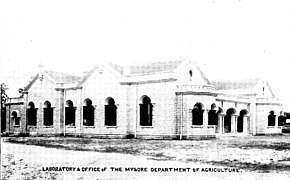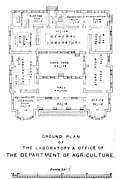Adolf Lehmann
Adolf Lehmann or Adolph Ludwig Ferdinand Lehmann[1] (1863-27 September 1937) was a Canadian chemist and agricultural scientist of German origin. He served as the first agricultural chemist of Mysore state in India.
Lehmann was born in Orillia, Ontario to a family of German settlers. He graduated in 1889 studied chemistry at the Guelph Agricultural College and then under Johannes Wislicenus at the University of Leipzig where he studied the reduction of dibenzene diphenylbutadiene to tetraphenylbenzene. He then worked at the Dominion Experimental Farm, Ottawa as an assistant chemist to Frank Thomas Shutt[2] and then as a chemist in New Orleans. In 1898 he moved to India to set up the department of agriculture in Mysore State. Lehmann's appointment was based on the recommendations of Dr Voelcker to the government of India.[3] Among his achievements were the establishment of rigorous experimental techniques based on pot cultures, field plots, and developing chemical assays for phosphorus in plant and animal matter. He studied soil fertility, and conducted research on improving the process of converting sugarcane juice to sugar (reducing losses by neutralizing with lime before boiling[4]), treating water for drinking, and in paper making.[5] In 1908, as his appointment term ended,[6] shortly after the death of his wife,[7] the Government of Mysore decided not to renew the position of Agricultural Chemist. The Planter' Association resolved in a meeting "That this Association deplores the retrograde policy of the Mysore Government with regard to agriculture by which the services of Dr Lehmann are lost to the Province. It desires to place on record its high appreciation of the valuable services rendered to the planting industry by Dr. Lehmann."[8] Lehmann had worked for nine years before he returned to Canada, to work initially at Queen's University, and then at the University of Alberta as a professor. He was succeeded in 1908 in the state of Mysore by Leslie Coleman who had been recruited as a mycologist. In Canada he studied bitumen deposits in the Athabasca river, studied soil chemistry and influenced numerous students. He was invalid for the last eight years of his life and died at Kingston, Ontario.[9][10]
 Lehmann's office
Lehmann's office Floor plan
Floor plan
References
- University of Toronto. Register of Graduates, &c., for 1890. 1890. p. 10.
- Anstey, T.H. (1986). "One hundred harvests. Research Branch Agriculture Canada 1886-1986. Historical Series No. 27". Agriculture Canada: 24. Cite journal requires
|journal=(help) - Anon. (1939). Report on the Progress of Agriculture in Mysore. Bangalore: Government Press. pp. 27-33.
- Lehmann, A. (1907). Improvement of the sugar industry of Mysore. The Agricultural Journal of India. 2. pp. 54-63.
- Lehmann, Adolf (1907). "Memorandum on the use of, and trade in, commercial fertilizers in southern India". Proceedings of the Board of Agriculture in India held at Cawnpore. Government of India: 57-70.
- [Bangalore]. The Pioneer, 26 February 1908, p. 3.
- "Scientific Officer". The Planter's Chronicle. 3 (6): 179-180. 1908.
- "Quarterly General Meeting held at Balehonnur on the 3rd August 1908". The Planters' Chronicle. 3 (8): 188. 1908.
- "Dr. Adolf Lehmann". Nature. 140 (3553): 960. 1937. doi:10.1038/140960a0.
- "The Alumni in Alberta". O.A.C. Review. 36 (10): 328-329. 1924.